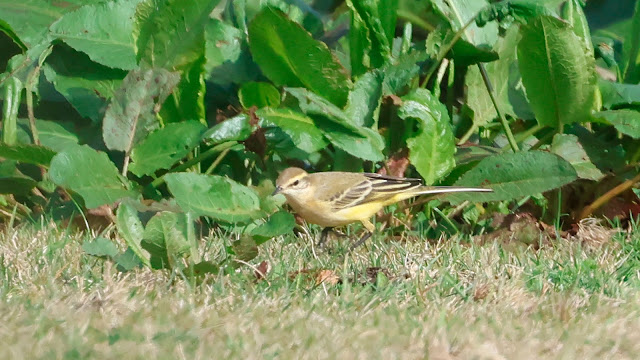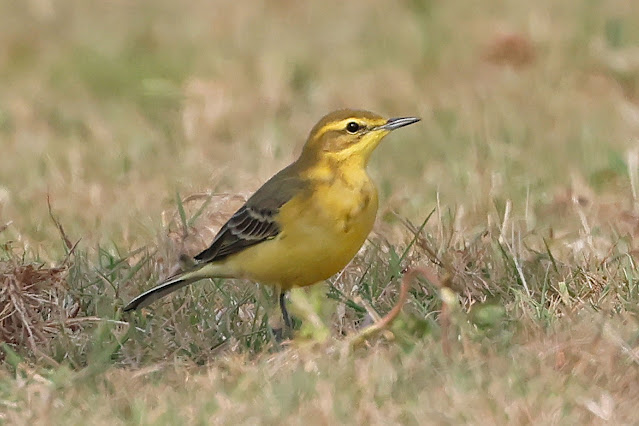I had arranged to meet Ian at the electricity sub station just outside the Solent Breezes Holiday Park this morning. There is one bird that you know will turn up at a certain location at this time of year, the Yellow Wagtail. I never seem to be able to catch up with them in the spring, but then they seem to move through in a purposeful manner. From the parked cars we walked to Workman's Lane and then on to the TLC for Horses field. Yellow Wagtail are pretty certain here and there had been reports through the week
It was another sunny day, although the sunshine was watery which with a freshening easterly wind was taking the edge off the temperature. As we walked towards the horses that were in a field close to the footpath we could see plenty of Yellow Wagtail buzzing around the horses as they grazed in the field. We edged closed to get better views.
The majority were duller birds, either juveniles or females, but there were also plenty of bright canary yellow adult males.
We walked around the training fields where not only were there more Yellow Wagtails, but also several Wheatear. Here a Wheatear in the bush with a Yellow Wagtail.
Getting the chance to photograph in the tree takes out some of the heat haze that can be problematic across the grass in the field.
A male Wheatear in the bush.
Both together showing well.
Estimating the number of Yellow Wagtails around us was difficult due to the fact that they would be constantly on the move. We picked on sixty, but this was very much a conservative estimate, there was very likely many more. I can't recall ever seeing so many in one place before. Look carefully and you will see so many around this horse.
There were Wheatear in the fields too, but with the heat haze the results of the photographs was not good.
The yellow wagtail likes damp marshes, meadows and farmland,
and spends much of its time running about on the ground, chasing insects
disturbed by the feet of livestock. Yellow wagtails nest on the ground or in
long grass, using plants, grasses and stems to build a cup-shape which they
line with fur. They can have up to two broods, each with five or six eggs. A
summer visitor, they arrive from their African wintering grounds from March
onwards, with the return passage peaking here on the south coast around the end of August and early September.
We walked back to the field with horses close to the footpath and were treated to several spanking males running around the horses.
With so many birds scattered across the fields it was no surprise to see a Sparrowhawk. It came low across the grass, alarm calls rang out and the birds scattered, and the Sparrowhawk came away missing out. It headed off towards Workman's lane.
The wagtails soon returned unconcerned by the threat of the Sparrowhawk and continued to feed around the horses. As well as the Yellow Wagtails there were also Pied. This one using the hay crate as a launch pad to take insects off the horses.
Another superb male bird close to the horses.
Still photographs do not convey how busy these birds are as the feed around the livestock, so I took the opportunity to take some video.
The male bird a little closer
And to compare, a female.
Eventually we walked away and as we passed the gate to go down towards the beach area we had a very smallish orange butterfly flying like a hairstreak around the bushes. Unfortunately it didn't stop, but we were pretty much convinced that this was a Brown Hairstreak.
We walked down the path towards the sea and I passed comment that you never seem to see anything in the pony field anymore. As the words left my mouth, Ian picked out a Wheatear om a fence post.
We edged closer and it stayed on the post.
We walked around to the other side where we could edge even closer and also get some wonderful backgrounds, this one from ragwort in the field.
Looking for any food opportunity.
And any danger from above.
Wheatear are such smart looking birds, so photogenic.
Another different aspect and another background.
It then dropped to the ground and eventually found this old log to perch on.
Walking along the beach there were more Wheatear, four in total around the old dead gorse branches.
We walked on to the scrape where there were 34 Avocet and about the same number of Black-tailed Godwits, but no other waders. We decided to head back and again the Wheatear amongst the dead gorse.
Three on the fence posts at one point.
Two Sandwich Terns were flying up and down the beach.
Walking back past the Pony Field there was a group of Whitethroats and as we watched them Ian picked out a Whinchat sitting on the top of the bushes.
It would fly catch and then return to almost the same spot, despite us hoping it would come closer.
After some lunch we decided to take the short journey to Posbrook Floods. Walking down the canal path there were hirundines moving through, though it was strange to see them heading up the valley in a northerly direction.
Reaching Posbrook, it was not easy viewing the open water, you had to find a raised part of the bank that allowed a view of the water and the edge of the reeds on the far side. We could see four Green Sandpipers feeding under the reeds.
Then Ian picked up the Glossy Ibis feeding along the reeds, walking past three Little Egrets.
This Glossy Ibis has been around for a few weeks and hopefully it will now stay through the autumn and winter once more. There were nine the last weekend, but they appear to have moved on leaving this one bird.
Walking back to the car park a Kestrel flew up into one of the oak trees along the canal path. It sat there and watched the field below.
I was taken by the size of the eyes in comparison with the rest of the head.
So the Yellow Wagtails have been seen and in numbers I have never experienced before. It was also nice to get some great views of Wheatear.


















































No comments:
Post a Comment